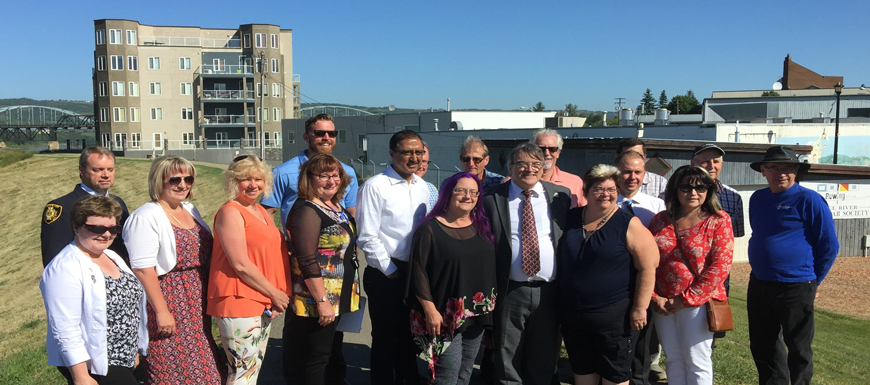Allow me to start by acknowledging that this official start to the construction of our second highway bridge is being held on traditional Treaty 8 lands on the banks off the Peace River, the peace boundary between the Beaver and Cree First Nations. The Peace River is probably the most dominant geographical feature of Treaty 8 lands. It is certainly the largest river in Alberta. Fifty percent of all of the water in Alberta flows through the Peace. It really is a mighty and formidable river. The project that we are officially initiating today will again span the Peace by constructing a sister bridge parallel to the current highway bridge.
I certainly want to express my thanks and appreciation to the federal and provincial governments represented here today by the Federal Minister of Infrastructure and fellow Albertan, the Hon. Amarjeet Sohi – welcome home , sir – and our own MLA, the Deputy Speaker of the Legislature, the Hon. Debbie Jabbour – welcome home for the summer recess. I want to thank both of you for recognizing the value of this project and sponsoring the project.
This $160-milion bridge is an important project. With its 200-direct jobs for the next three to four years, it will help us punch through this economic trough precipitated by low-oil prices. I can tell you that this project has already saved Peace-River-area jobs and kept Peace-River-area companies afloat.
This is also a bridge that is going to pay dividends for a long time. It is laying down the foundation of a prosperous future. It and its sister bridge will serve as the link between the riches and resources of northwestern Alberta and the NWT and the rest of Alberta, Canada and the world.
And, it isn’t just oil and gas riches and resources – it is forestry, it is agriculture, it is bio-resources. It is the rare earth metals of Ironstone and the precious gems of the Northwest Territories. This bridge will play a pivotal role in securing Canada’s economic prosperity and Alberta’s economic future. Peace River is the gateway to northwest Alberta and to the Northwest Territories. This bridge is going to expand that gateway.
Last, but certainly not least, this bridge is going to save lives, it is going to save injuries. The current highway bridge is 49 years old. Built in 1968, it was designed to handle 3,500 vehicles a day. It now accommodates over 17,000 vehicles a day. So, you can see why safety is a top-of-mind priority for Peace River residents. This bridge will help take the safety burden off her sister bridge; it will minimize the risk of accidents; it will improve first responder reaction times. Double-laned bridges, like double-laned highways, save lives.
Thank you again Mr. Sohi and Mme. Jabbour for helping to make the second highway bridge a reality.

